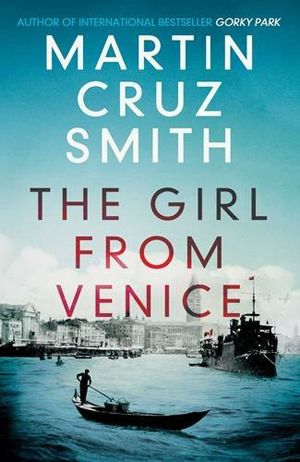 Written by Martin Cruz Smith — Martin Cruz Smith is the multi-award winning author of the Arkady Renko series which began with Gorky Park in 1980. Set inside Brezhnev’s Russia, it was made into a movie starring William Hurt and Lee Marvin. With The Girl From Venice, Cruz Smith has crafted a standalone novel and the setting is Venice in 1945. As he has done so brilliantly in the past, again the author evokes a very strong sense of time and place, then dumps a handful of well-defined characters into a slow burn series of events which steadily wind up to a conclusion.
Written by Martin Cruz Smith — Martin Cruz Smith is the multi-award winning author of the Arkady Renko series which began with Gorky Park in 1980. Set inside Brezhnev’s Russia, it was made into a movie starring William Hurt and Lee Marvin. With The Girl From Venice, Cruz Smith has crafted a standalone novel and the setting is Venice in 1945. As he has done so brilliantly in the past, again the author evokes a very strong sense of time and place, then dumps a handful of well-defined characters into a slow burn series of events which steadily wind up to a conclusion.
Although World War II is all but over, Italy remains occupied by the Third Reich. Italy’s fascist leader Benito Mussolini has retreated to his mansion in Salo, seemingly more focused on his love life than the war.
Innocenzo Vianello, or Cenzo to his friends, is a fisherman from the village of Pellestrina which lies across from Venice on a lagoon. The Germans have imposed a curfew on all nighttime activities, except fishing. Cenzo is out on his boat, catching cuttlefish. When the body of a pale, teenage girl enters his nets his life changes forever.
A woman on a boat is deemed bad luck, but a dead one is far worse. Nevertheless, Cenzo drags her corpse aboard, covers her with canvas and sets off back to Pellestrina.
En route, he is stopped by a German gunboat out searching for something. Led by Lieutenant Hoff they search Cenzo’s boat though they find nothing, not even the dead girl. She’s gone. Hoff is drunk and he smashes up Cenzo’s gear. When the Germans depart the girl reappears – she was not in fact dead, just pretending to be, but won’t answer any of Cenzo’s questions.
He gives up and resumes his journey, but the Germans reappear. Hoff is clearly suspicious of Cenzo. The girl swims to a nearby island where the gunboat moors too. Hoff, answering a call of nature, finds the girl but Cenzo kills the German and hides his body.
Back in Pellestrina the girl finally reveals she is called Giulia and is the daughter of a wealthy Jewish family who were plotting resistance against the Germans. They were betrayed and only Giulia escaped. Hoff was looking for her and Cenzo keeps Giulia hidden at his house. Over the coming weeks they learn more about each other, though neither is quite the person they initially seemed to be.
Eventually, with the war closing in, Cenzo decides it would be better for Giulia to be smuggled out of the country. He has a contact, Russo, who’s with the partisans. Giulia leaves, though Cenzo hears nothing from her again until a few weeks later when Russo turns up dead. Cenzo sets off to find Giulia in the last place Russo was seen – decadent Salo where Mussolini is holed up.
The interplay between Cenzo, a man of hidden depths and substantially more than a simple fisherman, and wealthy Giulia is the central theme which runs through the story and how a chance encounter changes them both forever.
It is very difficult to fault this beautifully constructed and very well written story which is simply a pleasure to read. It is deceptively prosaic, the characters rich and full. Cruz Smith wonderfully offsets the cruelty and harshness of war and how it affects people against the backdrop of Venice and its lagoon – apparently a city which the Allies would not bomb so remained unaffected by that at least. All in all this is a book which should be read slowly and savoured…
For more World War II crime fiction, try Alan Furst’s A Hero in France.
Simon & Schuster
Print/Kinde/iBook
£8.99
CFL Rating: 5 Stars








